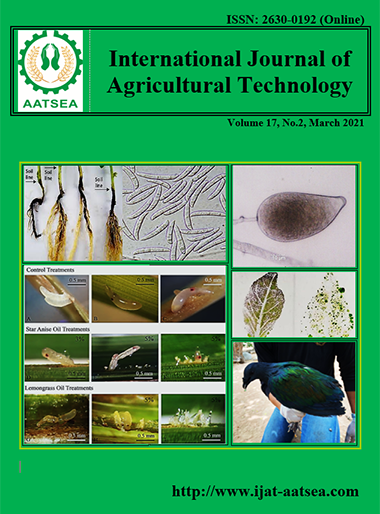Application of Chaetomium cochliodes CTh02 to against durian root rot cause by Phytophthora palmivora RT01
Main Article Content
Abstract
The durian is cultivated in tropical regions which are caused root rot by Phytophthora palimovora RT01. P. palmivora RT01 causing root rot of durian var. monthong was proved to be pathogenic isolate and confirmed morphological and phylogenetic identification. Chaetomium cochliodes CTh02 proved to be antagonized P. palmivora RT01 causing root rot of durain var. monthong through dual culture evaluation. Crude hexane, crude ethyl acetate and crude methanol extracts of Ch. cochliodes CTh02 significantly inhibited colony growth of P. palmivora RT01 at the ED50 values of 955, 402 and 240 ppm., respectively. Morevover, Crude methanol extracts gave significantly highest inhibited sporangia of P. palmivora RT01 which ED50 value of 25 ppm and followed by crude hexane, crude ethyl acetate extracts which the ED50 values of 163, and 339 ppm, respectively. The control mechanism Ch. cochliodes CTh02 against P. palmivora RT01 may possible act as antibiosis
Article Details

This work is licensed under a Creative Commons Attribution-NonCommercial-NoDerivatives 4.0 International License.
References
Aggarwal, R., Tewari, A. K., Srivastava, K. D. and Singh, D. V. (2004). Role of antibiosis in the biological control of spot blotch (Cochliobolus sativus) of wheat by Chaetomium globosum. Mycopathologia, 157:369-377.
Chan, L. G. and Kwee, L. T. (1986). Comparative in vitro sensitivity of selected chemicals on Phytophthora palmivora from cocoa and durian. Pertanika, 9:183-191.
Chee, K. H. (1969). Phytophthora leaf disease in Malaysia. Journal of the Rubber Research Institute of Malaya, 21:79-86.
Chee, K. H. (1974). Hosts of Phytophthora palmivora. Phytophthora Disease of Cocoa. In PH Gregory, ed. Longman, London, pp.81-87.
Doyle, J. J. and Doyle, J. L. (1987). A rapid DNA isolation procedure for small quantities of fresh leaf tissue. Phytochemical Bullettin, 19:11-15.
Erwin, D. C. and Ribeiro, O. K. (1996). Phytophthora diseases worldwide. American Phytopathological Society (APS Press).
Fatima, N., Mukhtar, U., Ihsan-Ul-Haq, M. A. Q., Jadoon, M. and Ahmed, S. (2016). Biological evaluation of endophytic fungus Chaetomium sp. NF15 of Justicia adhatoda L.: a potential candidate for drug discovery. Jundishapur journal of microbiology, 9:1-12.
Hung, P. M., Wattanachai, P., Soytong K. and Poeaim, S. (2015). Biological control of Phytophthora palmivora causing root rot of Pomelo using Chaetomium spp. Mycobiology, 43:63-70.
Kanokmedhakul, S., Kanokmedhakul, K., Nasomjai, P., Louangsysouphanh, S., Soytong, K., Isobe, M. and Suksamrarn, A. (2006). Antifungal Azaphilones from the Fungus Chaetomium cupreum CC3003. Journal of natural products, 69:891-895.
Kumar, R., Kundu, A., Dutta, A., Saha, S., Das, A. and Bhowmik, A. (2020). Chemo-profiling of bioactive metabolites from Chaetomium globosum for biocontrol of Sclerotinia rot and plant growth promotion. Fungal Biology. https://doi.org/10.1016/j.funbio.2020.07.009.
Linkies, A., Jacob, S., Zink, P., Maschemer, M., Maier, W. and Koch, E. (2020). Characterization of cultural traits and fungicidal activity of strains belonging to the fungal genus Chaetomium. Journal of Applied Microbiology, 1-17.
Naqvi, S. A. (2004). Diagnosis and management of certain important fungal diseases of citrus. In: Naqvi SA, editor. Diseases of fruits and vegetables. Dordrecht: Kluwer Academic Publishers, pp.247-90.
Phonkerd, N., Kanokmedhakul, S., Kanokmedhakul, K., Soytong, K., Prabpai, S. and Kongsearee, P. (2008). Bis-spiro-azaphilones and azaphilones from the fungi Chaetomium cochliodes VTh01 and C. cochliodes CTh02. Tetrahedron, 64:636-9645.
Prommate, A., Valyasevi, S., Arunothayanan, H., McGovern, R. J., Cheewankoon, R. and To-anun, C. (2019) Antagonistic activities of Chaetomium spp. on Phytophthora palmivora (P-05) from durian root and stem rot. Khonkaen Agriculture Journal, 6:1251-1264.
Sönmez, C. and Mamay, M. (2018). Biological control in sustainable agriculture. In Proceedings of the International GAP Agriculture and Livestock Congress, Sanliurfa, Turkey, 25–27 April 2018, pp.362.
Soytong, K. (2010). Evaluation of Chaetomium-Biological Fungicide to Control Phytophthora Stem and Root Rot of Durian. Research Journal, 3:117-124.
Tongon, R. and Soytong, K. (2016). Fungal Metabolites from Chaetomium brasilense to Inhibit Fusarium solani. International Journal of Agricultural Technology, 12:1463-1472.
Wang, X. W., Houbraken, J., Groenewald, J. Z., Meijer, M., Andersen, B., Nielsen, K. F. and Samson, R. A. (2016a). Diversity and taxonomy of Chaetomium and Chaetomium-like fungi from indoor environments. Studies in Mycology, 84:145-224.
Wang, X. W., Lombard, L., Groenewald, J. Z., Li, J., Videira, S. I. R., Samson, R. A. and Crous, P. W. (2016b). Phylogenetic reassessment of the Chaetomium globosum species complex. Persoonia: Molecular Phylogeny and Evolution of Fungi, 36:83-133.
Zhang, G., Wang, F., Qin, J., Wang, D., Zhang, J., Zhang, Y. and Pan, H. (2013). Efficacy assessment of antifungal metabolites from Chaetomium globosum No. 05, a new biocontrol agent, against Setosphaeria turcica. Biological Control, 64:90-98.
Zhao, S. S., Zhang, Y. Y., Yan, W., Cao, L. L., Xiao, Y. and Ye, Y. H. (2017). Chaetomium globosum CDW7, a potential biological control strain and its antifungal metabolites. Microbiology Letters, 364:1-6.


